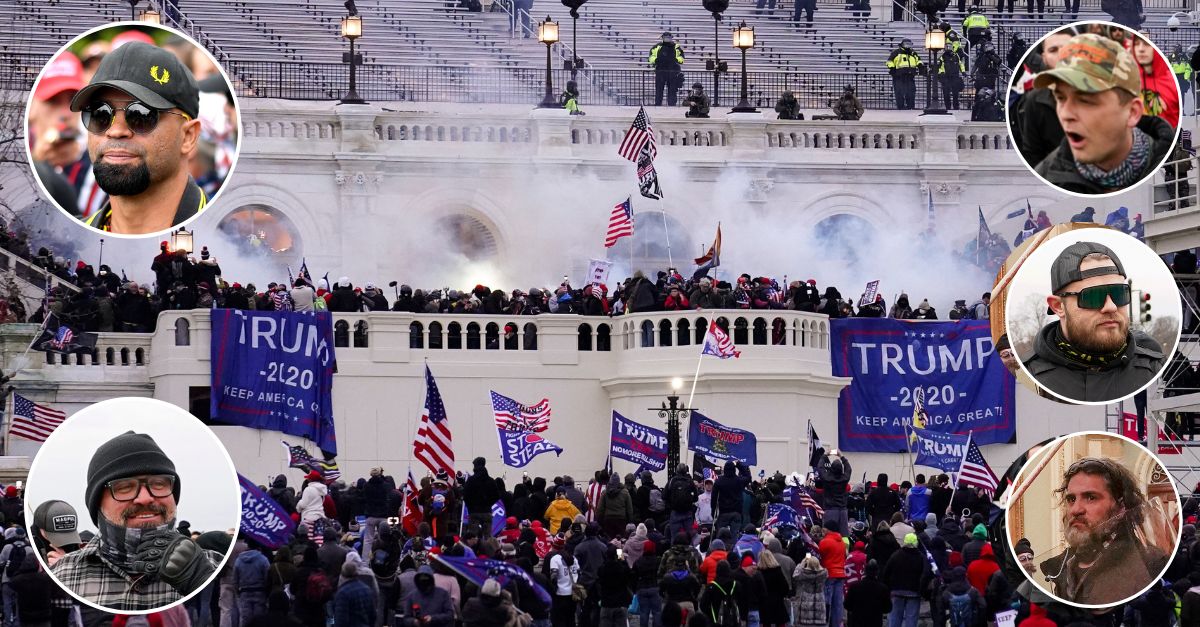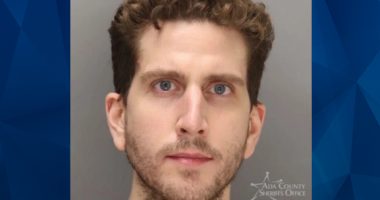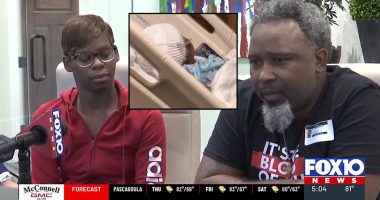
Violent insurrectionists loyal to President Donald Trump, storm the Capitol, Jan. 6, 2021, in Washington (AP Photo/John Minchillo, File). Insets, clockwise starting from top left: Enrique Tarrio (AP Photo/Noah Berger, File); Zachary Rehl (AP Photo/Carolyn Kaster, File); Ethan Nordean (AP Photo/Carolyn Kaster, File); Dominic Pezzola (AP Photo/Manuel Balce Ceneta, File); Joseph Biggs (AP Photo/Carolyn Kaster, file)
Federal prosecutors want leaders of the Proud Boys extremist group convicted of plotting to keep Donald Trump in power despite losing the 2020 presidential election to spend decades behind bars.
Enrique Tarrio, top Proud Boys lieutenants Ethan Nordean and Joseph Biggs, and Proud Boys members Zachary Rehl and Dominic Pezzola were convicted in May of seditious conspiracy and other charges in connection with the Jan. 6 attack on the U.S. Capitol, when a mob of Donald Trump supporters, spurred on by the former president’s false statements that fraud affected the outcome of the 2020 presidential election, overwhelmed police and broke into the U.S. Capitol as Congress had begun to certify Joe Biden’s 2020 electoral win.
In a sentencing memo filed Thursday, federal prosecutors argue that because they participated in a conspiracy, each defendant should “be liable for his own conduct plus the conduct of all his co conspirators on the afternoon of January 6, to include the actual or threatened property damage and injury to others caused by those who breached the Capitol.”
Prosecutors asked for a sentence of 33 years for Tarrio and Biggs, 27 years for Nordean, 30 years for Rehl, and 20 years for Pezzola. All requests surpass the longest Jan. 6-related prison sentence to date — 18 years for Oath Keepers founder Stewart Rhodes, who was convicted in November of seditious conspiracy, obstruction of Congress, and other charges. Prosecutors had wanted Rhodes to serve 25 years behind bars. Notably, documentary footage shows Tarrio and Rhodes meeting in the parking garage of a hotel near the Capitol on Jan. 5, 2021.
In their filing, prosecutors noted that their request calls for sentences to be “stacked” or run consecutively, rather than concurrently, due to the seriousness of the offense, the need for appropriate punishment and adequate deterrence, and to protect the public.
“For years, these defendants intentionally positioned themselves at the vanguard of political violence in this country,” the government’s sentencing memo says. “They brought that violence to the Capitol on January 6 in an effort to change the course of American history, and the sentences imposed by this Court should reflect the seriousness of their offenses.”
Prosecutors say that Tarrio and his co-defendants should serve even more time behind bars than Rhodes and the Oath Keepers convicted of seditious conspiracy and other charges.
“[T]hese defendants are distinct from all other January 6 defendants, including the Oath Keepers, because of their role in coordinating and instigating the attack on the Capital with their large numbers,” the memo says.
“No other group of defendants had a bigger impact on the events of January 6 than these defendants and the men in their command,” the memo adds.
Prosecutors argue that a terrorism sentencing enhancement should apply, citing a handful of other seditious conspiracy cases involving people accused of supporting efforts of foreign terrorist groups in Pakistan and Afghanistan.
“These other seditious conspiracy cases show that courts have imposed decades-long sentences of incarceration even for planning and preparing for violence (but not using actual violence) against the United States government,” the memo says. “Indeed, the seditious conspiracy statute was created to address such existential threats to our system of government.”
The sentencing enhancement “is applicable regardless of the defendants’ claims that they believed that they were stopping a fraudulent election and aimed to stop communists from taking over the
United States,” the memo says, citing a U.S. Court of Appeals ruling that “if [defendants] use violence and intimidation to further their views, they are terrorists.”
Notably, U.S. District Judge Amit Mehta opted to add the enhancement to his calculation of Rhodes’ ultimate sentence.
Regarding Tarrio specifically, the government argues that the decades-long sentence — including a terrorism enhancement — is justified because of Tarrio’s unique role in leading the Proud Boys that day.
“Tarrio is an individual of uncommon ability,” the government says, praising the top-ranking Proud Boys leader (citations omitted). “He is intelligent, charming, creative, and articulate — a gifted communicator who excels at attracting followers and ‘creat[ing] compelling spectacles.’ Regrettably, Tarrio has used those talents to inflame and radicalize untold numbers of followers, promoting political violence in general and orchestrating the charged conspiracies in particular.”
When Tarrio posted, for example, that “‘liberty’ comes ‘[w]hen the government fears the people,”” the government argues, “Tarrio was not referring to politicians’ fear of being voted out of office. He was speaking concretely and approvingly about what the members of Congress and their staffs were experiencing that very afternoon: fear of injury and death at the hands of a vicious mob that included Tarrio’s own hand-picked soldiers.”
Tarrio later appeared to make his approval explicit, the government says.
Read Related Also: Accused Long Island Serial Killer’s Wife Hasn’t Been Questioned by Investigators, Lawyer Says
“To erase any doubt, Tarrio accompanied the post with a photograph of terrified legislators cowering in the gallery of the House chamber,” the memo says (citations removed). “Later that evening, Tarrio claimed he did not want the day’s events to ‘continue to happen,’ but that the ‘elected officials’ who had ‘created the problem’ had better ‘listen… Because things can get ugly.’ This veiled threat of further violence is the political version of an extortionate shakedown: Nice democracy you’ve got there; be a shame if something were to happen to it.”
Prosecutors argue that Tarrio’s absence at the Capitol that day — having been ordered to stay out of the city after his arrest for burning a Black Lives Matter flag at a historic Black church — was no accident, and that his arrest was in fact a calculated move on Tarrio’s part to spin up support for the impending violence.
“Tarrio knew full well that he would be arrested if he came to D.C., but he did so anyway, all while using his social media account to taunt law enforcement,” prosecutors write, pointing to a post from Tarrio urging police to “[c]ome get me if you feel like what I did was wrong. We’ll let the public decide.”
“Those same messages, and his social media activity, suggest that Tarrio strategically calculated his arrest as a means to inspire a reaction by his followers,” prosecutors say. “The arrest did, in fact, serve the Proud Boys’ strategic interests on January 6: both Biggs and Nordean delivered speeches to the marching group in which they portrayed Tarrio’s arrest as an injustice demanding a response. Clearly there was some pre-planning to this aspect of the rally, because although Tarrio was arrested less than 48 hours before the Proud Boys marching group assembled on the morning of January 6, various members arrived wearing custom ‘ENRIQUE TARRIO DID NOTHING WRONG’ t-shirts.”
As to the Proud Boys defendants as a group, prosecutors say that they were prepared for chaos on Jan. 6, “[h]aving already ravaged the streets of Washington, D.C. with violence on two prior occasions in the fall of 2020[.]”
The defendants and their recruits “participated in every consequential breach at the Capitol on January 6,” the memo said.
According to prosecutors:
They began their assault that day at 10 a.m., when Nordean, Biggs and Rehl marched an assembled group of nearly 200 individuals away from the speeches at the Ellipse and directly to the Capitol. They arrived at the First Street gate at 12:50 p.m., and Biggs led the crowd in chants of “Whose Capitol? Our Capitol!” and “Whose house? Our house!” Within three minutes, Nordean, Biggs, Rehl, and Pezzola helped lead the charge up the first street walkway with their men throwing aside bike racks and laying waste to anything that stood in their path. As Biggs proudly declared, “we’ve gone through every barricade thus far.” When the police attempted to reform a line, Nordean and Biggs moved to the front and again led the way. They violently tore down a black metal fence and continued their assault on the Capitol. Nearly an hour later, at approximately 1:30 p.m., when law enforcement appeared to have successfully controlled the crowd by pushing them back, the men again pushed forward. Nordean, Biggs, and Pezzola gathered at the base of the concrete stairs that led to the doors and windows of the Capitol with many of their co-conspirators and other men they had led to the Capitol. They again surged toward the Capitol and overwhelmed officers that had been battling the crowd for nearly an hour. Rehl sprayed an officer in the face. Pezzola smashed open a window, allowing the first rioters to enter the Capitol at 2:11 p.m., and Biggs entered close behind him with some of his men.
The defendants’ public boasts about participating in the riot — including an interview with Biggs in which he called Jan. 6 a “warning shot” to the government and a self-recorded video from Nordean in which he insulted a woman who didn’t appreciate that he was “part of f—— storming the Capitol … 1776, b—-” — left “no doubt” that they knew what they were doing.
According to prosecutors, the stakes of the sentencing decision could not be higher.
“The justice system’s response to January 6 will impact whether January 6 becomes an outlier or a watershed moment,” the memo says, referencing a 2022 poll showing that some 20% of Americans believe political violence would be justified “at least sometimes,” and 10% believe it would be justified if it meant re-installing Trump as president. “Left unchecked, this impulse threatens our democracy.”
Nordean has asked to serve less than two years behind bars for his seditious conspiracy conviction. That would essentially amount to time served, as he has been in federal custody since April 2021.
According to court filings, Biggs has requested a sentence range of 27 to 33 months, and Rehl is seeking a sentence of 24 to 37 months. Pezzola has requested a sentence in the “60 month range,” according to his sentencing memorandum.
Tarrio’s sentencing memorandum did not appear to have been filed at the time of publication of this story.
U.S. District Judge Timothy Kelly, the Trump-appointed judge overseeing the case, has scheduled a hearing for Aug. 29 in order to hear arguments on whether sentencing enhancements should be applied, as well as victim impact statements. It is not clear whether Kelly will issue his sentencing orders on that day.
Read the government’s sentencing request, below.
Have a tip we should know? [email protected]









